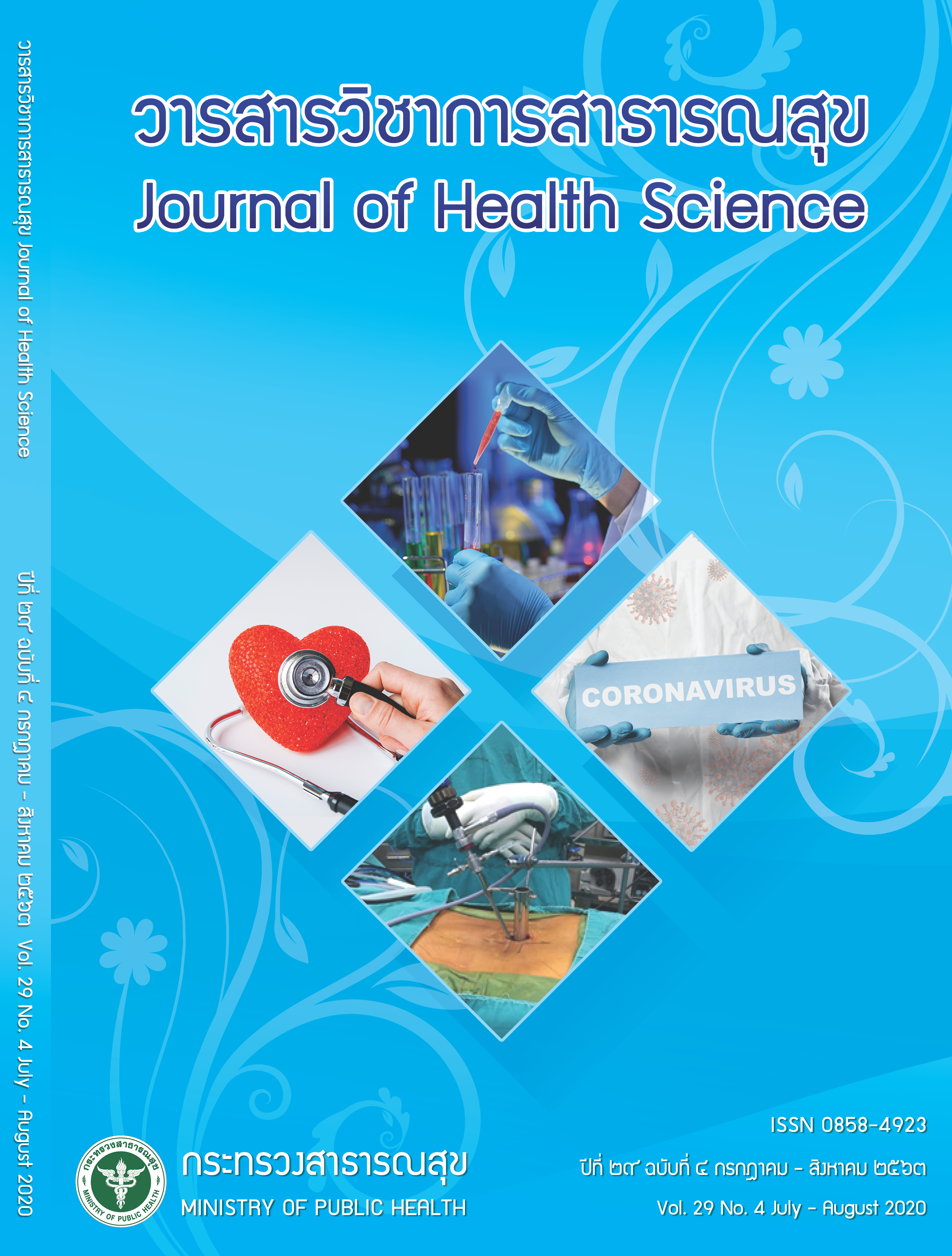Result of Minimal Invasive Lumbar Discectomy with Arthroscopic-Tubular Retractor System (Chiang Rai System)
Keywords:
herniated nucleus pulposus (HNP), micro endoscopic discectomy, minimal invasive spine surgeryAbstract
Nowadays, the minimal invasive spinal surgery technique was recognized from many centers for treated herniated nucleus pulposus (HNP) as it was not inferior to the standard technique and provided more benefit in less soft tissue injury, blood loss and shorter hospitalization. We had evaluated the outcome of local design Arthroscopic-tubular retractor system: Chiang Rai system. A retrospective study was performed at Chiang rai Prachanukroh Hospital in patients with herniated nucleus pulposus (HNP) during May 2016 to February 2019. All patients were operated for 1 level lumbar microdiscectomy with arthroscopic-tubular retractor system: Chiang Rai system by one surgeon. Numeric pain rating scale of back and leg pain, complications, length of stay, Oswestry low back disability index (ODI), and patient’s satisfaction using modified Macnab criteria were collected at the date of admission, 1st month, 6th month, 12th month and 24th month follow-ups. Thirty patients (16 males and 14 females) were included in the study. The average operating time was 134.5 minutes. Average blood loss was about 75.7 milliliters. Length of hospital stay was about 2.4 days. The mean NRS score of back pain/leg pain was improved from 6.7 to 1.5 and 8.4 to 0.9 respectively; and the mean ODI changed from 49.9 to 22.7 at 1stmonth, and gradually decrease along follow up study. Based on modified Macnab criteria, 86.6% patients had excellent to good results. Our designed “arthroscopic-tubular retractor system: Chiang Rai system” had quite satisfied results. Limitation of this study was small sample size, thus results of the use of this instrument would be collected continuously for more evaluation.
Downloads
References
Annertz M, Jonsson B, Stromqvist B, Holtas S. No re-lationship between epidural fibrosis and sciatica in the lumbar post discectomy syndrome. A study with con-trast-enhanced magnetic resonance imaging in symptom-atic and asymptomatic patients. Spine 1995;20(4): 449-53.
Fritsch EW, Heisel J, Rupp S. The failed back surgery syndrome: reasons, intraoperative findings, and long-term results: a report of 182 operative treatments. Spine 1996; 21(5):626-33.
Schoeggl A, Maier H, Saringer W, Reddy M, Matula C. Outcome after chronic sciatica as the only reason for lumbar microdiscectomy. J Spinal Disord Tech 2002; 15(5):415-9.
Dewing CB, Provencher MT, Riffenburgh RH, Kerr S, Manos RE. The outcomes of lumbar microdiscectomy in a young, active population: correlation by herniation type and level. Spine 2008;33(1):33-8.
Goald HJ. Microlumbar discectomy: follow-up of 477 patients. J Microsurg 1980;2(2):95-100.
Katayama Y, Matsuyama Y, Yoshihara H, Sakai Y, Nakamura H, Nakashima S, et al. Comparison of surgi-cal outcomes between macro discectomy and micro discectomy for lumbar disc herniation: a prospective randomized study with surgery performed by the same spine surgeon. J Spinal Disord Tech 2006;19(5):344-7.
Perez-Cruet MJ, Foley KT, Isaacs RE, Rice-Wyllie L, Wellington R, Smith MM, et al. Microendoscopic lumbar discectomy: technical note. Neurosurgery 2002; 51(5):S129–36.
Foley KT, Smith MM. Microendoscopic discectomy. Tech Neurosurg 1997;3:301–7.
Nopawan Sanjaroensuttikul. The Oswestry Low Back Pain Disability Questionnaire (Version 1.0) Thai Version. J Med Assoc Thai 2007;90(7):1417-22.
Macnab I. Negative disc exploration: an analysis of the cause of nerve root involvement in sixty-eight patients. J Bone Joint Surg Am 1971;53(5):891-903.
Mu X, Wei J, Li P. What were the advantages of mi-croendoscopic discectomy for lumbar disc herniation comparing with open discectomy: a meta-analysis? Int J Clin Exp Med 2015;8(10):17498-506.
Harrington JF, French P. Open versus minimally invasive lumbar microdiscectomy: comparison of operative times, length of hospital stay, narcotic use and complications. Minim Invasive Neurosurg 2008;51(1):30-5.
Patil A, Chugh A, Gotecha S, Kotecha M, Punia P, Ashok A, et al. Microendoscopic discectomy for lumbar disc herniations. J Craniovertebr Junction Spine 2018; 9(3):156-62.
Tait MJ, Levy J, Nowell M, Pocock C, Petrik V, Bell BA, et al. Improved outcome after lumbar microdiscec-tomy in patients shown their excised disc fragments: A prospective, double blind, randomised, controlled trial. J Neurol Neurosurg Psychiatry 2009;80(9):1044–6.
Katayama Y, Matsuyama Y, Yoshihara H, Sakai Y, Nakamura H, Nakashima S, et al. Comparison of surgi-cal outcomes between macro discectomy and micro discectomy for lumbar disc herniation: a prospective randomized study with surgery performed by the same spine surgeon. J Spinal Disord Tech 2006;19(5): 344–7.
McGirt MJ, Ambrossi GL, Datoo G, Sciubba DM, With-am TF, Wolinsky JP, et al. Recurrent disc herniation and long term back pain after primary lumbar discectomy: Review of outcomes reported for limited versus aggres-sive disc removal. Neurosurgery. 2009; 64(2): 338–44.
Wu X, Zhuang S, Mao Z, Chen H. Microendoscopic discectomy for lumbar disc herniation: surgical technique and outcome in 873 consecutive cases. Spine 2006; 31(23):2689-94.
Zhao LJ , Jiang WY, Ma WH, Xu RM, Sun SH. Mi-cro-endoscopic discectomy for the treatment of lumbar disc herniation in senile patients over seventy years old.Zhongguo Gu Shang 2011;24(10):811-5.
Nakagawa Y, Yoshida M, Maia K. Microendoscopic discectomy (MED) for surgical management of lumbar disc disease: technical note. Internet Journal of Spine Surgery 2005;2(2):1-7.
Zhang C, Zhou Y, Chu TW. Traumatic responses fol-lowing microendoscopic discectomy: clinical analysis of 44 patients. Zhonghua Yi Xue Za Zhi 2006; 86(43): 3039-42.
Kodeeswaran M, Ranganathan J, Sherina PR. Microen-doscopic discectomy (MED) for lumbar disc herniation: comparison of learning curve of the surgery and outcome with other established case studies. J Spine Surg 2018; 4(3):630–7.
Shriver MF, Xie JJ, Tye EY, Rosenbaum BP, Kshettry VR, Benzel EC, et al. Lumbar microdiscectomy compli-cation rates: a systematic review and meta-analysis. Neurosurg Focus 2015;39(4):1-11.
Downloads
Published
How to Cite
Issue
Section
License

This work is licensed under a Creative Commons Attribution-NonCommercial-NoDerivatives 4.0 International License.







